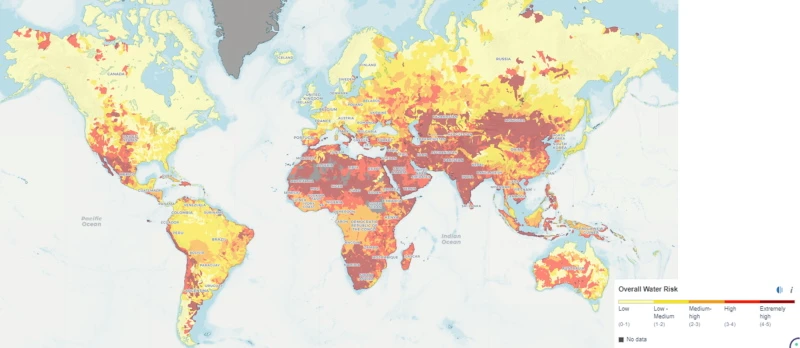Water stress, a global concern
Essential for life on Earth, water faces an existential challenge with the distressing decline of numerous freshwater basins worldwide. Water stress increasingly poses a risk to the stability of our planet, as it can cause water-dependent ecosystems to collapse. As such, freshwater scarcity is listed in the top five long-term risks in the last edition of the World Economic Forum Global Risk Report.1 Its ramifications extend across multiple facets of sustainable development, including human hygiene, food security, and involuntary migration.
Water consumption is also reflected in the Planetary Boundaries Framework.2 The nine planetary boundaries, which include land system change, biochemical flows, and novel entities, are key biophysical processes that regulate the resilience and stability of our planet. Recent research reveals that the freshwater change boundary, together with five other boundaries, have now been transgressed,3 meaning our planet is in a ‘zone of increasing risk’. This stresses how important it is to adequately address this issue in our SDG Framework.
“
Recent research reveals that the freshwater change boundary, together with five other boundaries, have now been transgressed, meaning our planet is in a ‘zone of increasing risk’
Data limitations
The Aqueduct Water Risk Atlas spotlights the regions around the globe that are grappling with acute water stress. In these places, the extraction of water exerts disproportionate pressure on already fragile ecosystems. Ideally, we would adopt a science-based approach and systematically assess companies’ volumes of water consumption against the regeneration rates of local watersheds. Such a lens can help avoid demand and supply imbalances. However, this requires spatially explicit data on water consumption along the value chains of thousands of companies, which is unfortunately not available. Instead, we have to take a global approach, although we can still take into account local context when assessing water stress.
Figure 1: Water stress around the globe

Source: Aqueduct Water Risk Atlas4
How we assess company impact on water scarcity
In consonance with the philosophy of our SDG Framework, we want to capture significant impacts that issuers have on water scarcity. Therefore, our assessment focuses on companies with substantial operations in regions experiencing high levels of water stress. In addition, we only include companies that operate in ‘critical impact sectors’ as defined by the Carbon Disclosure Project.5
Next, we opt for a forward-looking approach that assesses whether the trends in these companies’ water footprint are in line with a trajectory that brings us back within ‘safe operating spaces’ by 2030, the deadline of the SDG agenda. A recent technical report stressed that we are currently transgressing the planetary threshold for blue water, found in lakes, rivers and reservoirs, with a staggering 161–414 km3 per annum.6 In line with the precautionary principle, we aim for a reduction of 414 km3 of blue water consumption by 2030 to return to operating within the planetary threshold, which scientist have set at 4,000 km3.7 In order to achieve this goal, the world has to reduce its water consumption by 1.417% per year until 2030.
“
We want to capture significant impacts that issuers have on water scarcity.
Thus, companies whose water consumption declines by >1.417% per year on average can reasonably be perceived as adhering to a global pathway that is in harmony with the SDGs. Conversely, companies that are not reducing, and even in some cases increasing their water consumption, impede the SDGs. In addition, to avoid assigning positive/negative SDG scores to companies that currently have a high/low water footprint, we set thresholds on existing levels of water consumption. We assign positive and negative scores on SDGs 6 and 15 if companies meet the two criteria listed in Table 1 below.
Table 1: Water consumption and SDG scores

Source: Robeco 2023
As a result, around 20% of the companies in scope for the assessment receive a negative score. In line with the Pareto Principle, this group is accountable for roughly 80% of total water consumption by all companies in scope.
The data used in the assessment reflects companies’ direct water use that occurs in their own operations, as well as indirect freshwater use associated with business practices upstream in the supply chain. This way, vertically integrated companies are not unduly punished for high water footprints compared to those that have outsourced water-intensive activities to suppliers. For instance, food production is often highly water-intensive, though this is typically not reflected in the water use of downstream food producers, as the majority of water consumption occurs during upstream agricultural production.
“
We opt for a forward-looking approach that assesses whether the trends in these companies’ water footprint are in line with a trajectory that brings us back within ‘safe operating spaces’ by 2030
Next steps: Water discharge
Whereas water consumption volumes affect the quantity of available freshwater, discharge of untreated water can influence the quality of natural freshwater sources. Due to the lack of company disclosure on discharge water quality, for the time being our focus is on water consumption. However, we actively monitor new sources of information to improve our understanding of the impacts on water quality.
獲取最新市場觀點
訂閱我們的電子報,時刻把握投資資訊和專家分析。
Footnotes
1 https://www3.weforum.org/docs/WEF_Global_Risks_Report_2023.pdf
2 https://www.stockholmresilience.org/research/planetary-boundaries.html
3 https://www.science.org/doi/10.1126/sciadv.adh2458
4 https://www.wri.org/applications/aqueduct/water-risk-atlas/#/
5 https://www.cdp.net/en/investor/water-watch-cdp-water-impact-index
6 Grafton, R. Q., Krishnaswamy, J., & Revi, A. (2023). TECHNICAL REPORT-The Water Cycle and the Economy-March 2023.
7 https://www.science.org/doi/10.1126/science.1259855
免責聲明
本文由荷宝海外投资基金管理(上海)有限公司(“荷宝上海”)编制, 本文内容仅供参考, 并不构成荷宝上海对任何人的购买或出售任何产品的建议、专业意见、要约、招揽或邀请。本文不应被视为对购买或出售任何投资产品的推荐或采用任何投资策略的建议。本文中的任何内容不得被视为有关法律、税务或投资方面的咨询, 也不表示任何投资或策略适合您的个人情况, 或以其他方式构成对您个人的推荐。 本文中所包含的信息和/或分析系根据荷宝上海所认为的可信渠道而获得的信息准备而成。荷宝上海不就其准确性、正确性、实用性或完整性作出任何陈述, 也不对因使用本文中的信息和/或分析而造成的损失承担任何责任。荷宝上海或其他任何关联机构及其董事、高级管理人员、员工均不对任何人因其依据本文所含信息而造成的任何直接或间接的损失或损害或任何其他后果承担责任或义务。 本文包含一些有关于未来业务、目标、管理纪律或其他方面的前瞻性陈述与预测, 这些陈述含有假设、风险和不确定性, 且是建立在截止到本文编写之日已有的信息之上。基于此, 我们不能保证这些前瞻性情况都会发生, 实际情况可能会与本文中的陈述具有一定的差别。我们不能保证本文中的统计信息在任何特定条件下都是准确、适当和完整的, 亦不能保证这些统计信息以及据以得出这些信息的假设能够反映荷宝上海可能遇到的市场条件或未来表现。本文中的信息是基于当前的市场情况, 这很有可能因随后的市场事件或其他原因而发生变化, 本文内容可能因此未反映最新情况,荷宝上海不负责更新本文, 或对本文中不准确或遗漏之信息进行纠正。


